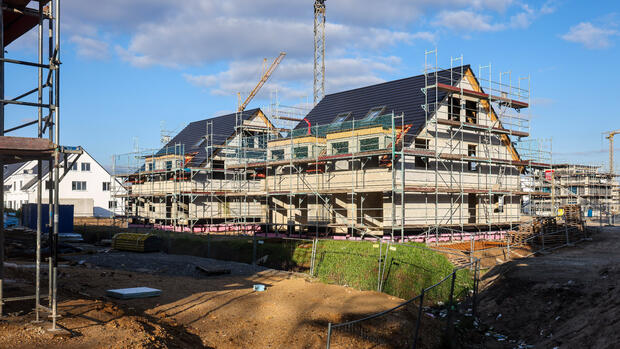Demand for real estate loans collapsed in the first quarter of 2023. The loan portfolio at the savings banks is now also falling.
(Photo: IMAGO/Rupert Oberhäuser)
Frankfurt The German savings banks are particularly affected by the weak demand for construction financing. Your portfolio of private real estate loans fell in the first quarter by 800 million euros to almost 389 billion euros, as the analysis company Barkow Consulting determined on the basis of Bundesbank data.
It’s the first quarterly decline in more than a decade. Most recently, the volume of construction financing at the savings banks had fallen slightly at the beginning of 2012. After that, the property boom that lasted for years ensured steadily increasing loan portfolios.
The savings banks are the market leaders in the real estate loan business for private customers. The portfolio had already grown only slightly at the end of last year. Now the demand has dropped again.
When asked, the German Savings Banks and Giro Association referred to the decline in new business as the reason for the slightly declining portfolios. The lobby association expects that, in view of the declining new business, “the bottom will be reached in the coming months”.
Industry-wide, net new business, i.e. new business less repayments, was EUR 1.3 billion in the first quarter, according to Bundesbank data. The loan portfolio rose to EUR 1.26 trillion at the end of March.
While the portfolio at the big banks stagnated, it increased at the Volks- und Raiffeisenbanken, the savings banks’ biggest competitors, by 500 million euros. The growth of 1.2 billion euros was particularly evident in the building societies.
The golden years are over
Peter Barkow, head of Barkow Consulting, points out that the first three months are traditionally the weakest quarter. “In this respect, the growth in the savings banks can definitely turn positive again in the second quarter.” The “fat growth years” are probably over for now.
The construction financing business, which is important for German financial institutions, collapsed in the course of the interest rate turnaround. The decline at the beginning of the year was particularly severe. New business in the first quarter of 2023 fell by a good 50 percent compared to the first quarter of 2022.
March 2022 was the previous record month with 32 billion euros in new business. At that time, many people had taken out real estate financing in anticipation of rising interest rates.
The development of financiers of large real estate projects is similar. In the first quarter of 2023, the members of the Association of German Pfandbrief Banks granted real estate financing of almost 26 billion euros – a decrease of almost 48 percent compared to the same quarter last year, as shown by data from Monday. This is an increase compared to the fourth quarter of 2022. “However, the demand for real estate financing is basically still at a low level in a long-term comparison,” according to the association.
Higher interest rates cause demand to collapse
The reasons for the slump in private and commercial real estate are the real estate interest rates, which have risen significantly with the turnaround in interest rates, higher material prices and the general uncertainty. Not only is the demand for home loans falling. Many financial institutions are also likely to become more cautious in lending. The recent nervousness in the banking market could also dampen business.
Private real estate loans recently made up the largest share in the loan book of German financial institutions at a good 40 percent. Accounting and consulting firm PwC recently concluded that profit margins have fallen significantly over the past year. Accordingly, the gross margins on real estate loans fell to 0.39 percent in 2022, by far the lowest value in ten years. In 2021 they were still 1.04 percent, in 2020 even 1.18 percent.
The reason for this: the refinancing costs of the banks have risen much faster than the interest rates that they were able to impose on customers. Refinancing costs are the interest costs that banks have to bear themselves when they procure the funds for construction financing, for example. The margins on construction loans are traditionally relatively low, but the risk of default is also considered low.
More: Where real estate prices fall particularly sharply
